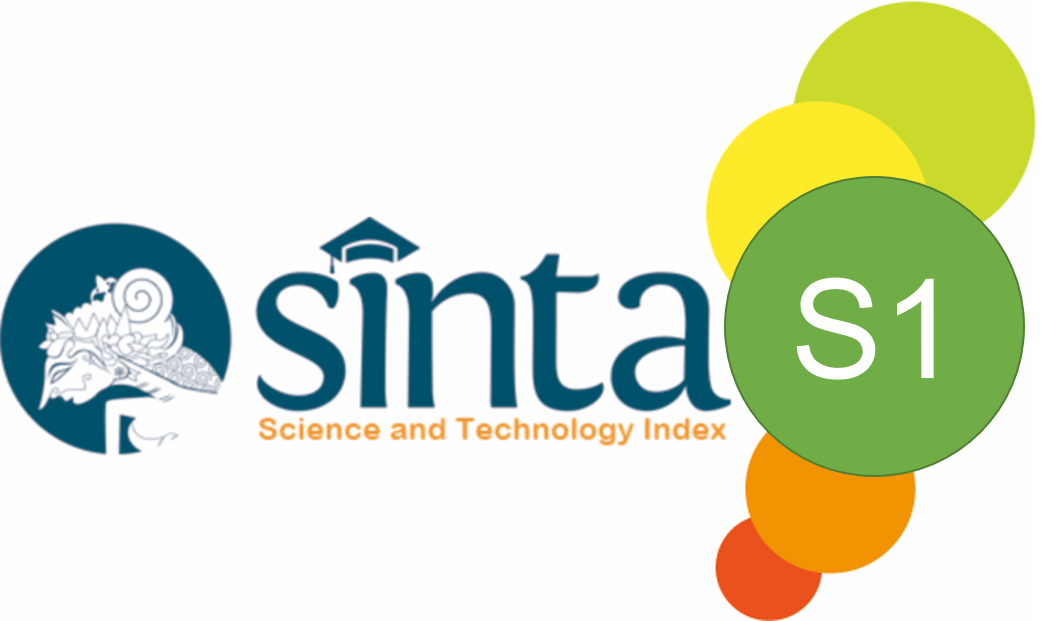Removal of Methylene Blue by Adsorption onto Activated Carbon From Coconut Shell (Cocous Nucifera L.)
Abstract
This research has been conducted on process of production activated carbon from coconut shells, which are activated both physics and chemistry to improve the adsorption of methylene blue. The process of physical activation was done by burning the coconut shell using a furnace at a temperature of 700°C. The chemical activation was done using H3PO4 activator. The result of activated carbon physical activation (CAP) has a greater absorbency than activated carbon chemical activation (CAC) with each of the absorption of methylene blue at 99.42 and 98.64%. Analysis of surface morphology on the adsorbent was performed using a Scanning Electron Microscope (SEM). SEM results indicated that (CAP) has a surface morphology that is relatively similar to commercial activated carbon (CACm). Adsorption test was conducted on the determination of the optimum pH, adsorption rate, and isotherm adsorption of methylene blue. The results of the optimum pH on CAC, CAP, and CACm respectively obtained at pH 8 and the optimum contact time is obtained respectively at 40, 60, and 80 minutes. Adsorption kinetics data of methylene blue on CACm, CAP, and CAC tend to follow the pseudo second order kinetics with a correlation coefficient (R2) is 0.937; 0.950; and 0.999, respectively. Adsorption isotherm of methylene blue on CACm, CAP, and CAC tend to follow the model of Freundlich isotherms.
Keywords
Full Text:
PDFReferences
Abd EL- Latif, M. M., and Ibrahim, A. M. (2009). Adsorption, Kinetic, and equilibrium studies on removal of basic dye from aqueous solutions using hydrolyzed oak sawdust. Desalination Water Treatment, 6(1-3), 252-268.
Anshar, A. M., Taba, P., and Raya, I. (2016). Kinetic and Thermodynamics Studies the Adsorption of Phenol on Activated Carbon from Rice Husk Activated by ZnCl2. Indonesian Journal of Science and Technology, 1(1), 47-60.
Attia, A. A., Girgis, B. S., and Fathy, N. A. (2008). Removal of methylene blue by carbons derived from peach stones by H3PO4 activation: batch and column studies. Dyes Pigments, 76(1), 282–289.
Auto, M., and Hammed, B. H. (2011). Preparation of waste tea activated carbon using potassium acetate as an activating agent for adsorption of acid blue. Chemical Engineering Journal, 171, 502-509.
Buhani, Suharso, and Aprilia, L. (2012) Chemical stability and adsorption selectivity on Cd2+ Ionic imprinted Nannochloropsis sp material with silica matrix From tetraethyl orthosilicate. Indonesian Journal of Chemistry, 12(1), 94 – 99.
Buhani, Suharso, and Fitriyani, A. Y. (2013). Comparative Study of Adsorption Ability of Ni (II) and Zn(II) Ionic Imprinted Amino-Silica Hybrid Toward Target Metal in Solution. Asian Journal of Chemistry, 25(5), 2875-2880.
Buhani, Narsito, Nuryono, Kunarti, E. S., and Suharso (2015). Adsorption competition of Cu(II) ion in ionic pair and multi-metal solution by ionic imprinted amino-silica hybrid adsorbent. Desalination Water Treatment, 55(5), 1240-1252.
Buhani, Rinawati, Suharso, Yuliasari, D. P., and Yuwono, S. D. (2017). Removal of Ni(II), Cu(II), and Zn(II) ions from aqueous solution using Tetraselmis sp. biomass modified with silica-coated magnetite nanoparticles. Desalination Water Treatment, 80, 203-213.
Dhidan, S. K. (2012). Removal of phenolic compunds from aqueous solutions by adsoption onto activted carbons prepared from date stones by chemical activation with FeCl3. Journal of Engineering, 18(1), 63-77.
El-Guendi, M. (1991). Homogeneous surface diffusion model of basic dyestuffs onto natural clay in batch adsorbers. Adsorption Science and Technology, 8(2), 217–225.
Foo, K. Y., and Hammed, B. H. (2011). Preparation, characterization and evaluation of adsorptive properties of orange peel based activated carbon via microwave induced K2CO3 activation. Bioresource Technology, 104, 679-686.
Gialamouidis, D., Mitrakas, M., and Liakopoulou-Kyriakides, M. (2010). Equilibrium,
Thermodynamic and Kinetic Studies on Biosorption of Mn(II) from Aqueous Solution by Pseudomonas sp., Staphylococcus xylosus and Blakeslea trispora Cells. Journal of Hazardous Materials, 182(1-3), 672-680.
Gupta, S. S., and Bhattacharyya, K. G. (2005). Adsorption of Ni(II) on clays. Journal of Colloid and Interface Science, 95(1), 21-32.
Gupta, V. K., Patania, D., Agarwal, S., and Singh, P. (2012). Adsorptional photocatalytic
degredation of methylene blue onto pectin-CuS nanocomposite under solar ligh. Journal of Hazardous Materials, 243, 179-186.
Hammed, B.H. (2009). Spent tea leaves: a new non-conventional and low-cost adsorbent for removal of basic dye from aqueous solutions. Journal of Hazardous Materials, 161(1-3), 753-759.
Hameed, B. H., Din, A. T. M., and Ahmad, A. L. (2007). Adsorption of methylene blue onto bamboo-based activated carbon: kinetics and equilibrium studies. Journal of Hazardous Materials, 141(3), 819–825.
Han, R., Zou, W., Yu, W., Cheng, S., Wang, Y., and Shi, J. (2007). Biosorption of methylene blue from aqueous solution by fallen Phoenix tree’s leaves. Journal of Hazardous Materials, 156–162.
Ho, Y. S., and McKay, G. (1998), Sorption of dye from aqueous solution by peat. Chemical Engineering Journal, 70(2), 115–124.
Kalavathy, M. H., Karthikeyan, T., Rajgopal, S., and Miranda, L. R. (2005). Kinetic and isotherm studies of Cu(II) adsorption onto H3PO4-activated rubber wood sawdust. Journal of Colloid Interface Science, 292(2), 354–362.
Karagozoglu, B., Tasdemir, M., Demirbas, E., and Kobya, M. (2007). The adsorption of basic dye (Astrazon Blue FGRL) from aqueous solutions onto sepiolite, fly ash and apricot shell activated carbon: kinetic and equilibrium studies. Journal of Hazardous Materials, 147(1-2), 297–306.
Langergren, S., and Svenska, B. K. (1898). Zur theorie der sogenannten adsorption geloester Stoffe. Veternskapsakad Handlingar, 24(4), 1–39.
Langmuir, I. (1916). The constitution and fundamental properties of solids and liquids. Journal of the American Chemical Society, 38(11), 2221-2295.
Nandiyanto, A. B. D., Sofiani, D., Permatasari, N., Sucahya, T. N., Wiryani, A. S., Purnamasari, A., and Prima, E. C. (2016). Photodecomposition profile of organic material during the partial solar eclipse of 9 March 2016 and its correlation with organic material concentration and photocatalyst amount. Indonesian Journal of Science and Technology, 1(2), 132-155.
Nandiyanto, A. B., Putra, Z. A., Andika, R., Bilad, M. R., Kurniawan, T., Zulhijah, R., and Hamidah, I. (2017). Porous activated carbon particles from rice straw waste and their adsorption properties. Journal of Engineering Science and Technology, 12, 1-11.
Nandiyanto, A. B. D., Zaen, R., and Oktiani, R. (2018). Working Volume in High-Energy Ball-Milling Process on Breakage Characteristics and Adsorption Performance of Rice Straw Ash. Arabian Journal for Science and Engineering, 43(11), 6057-6066.
Nemr, A. E., Abdel, W. O., Amany, E. S., and Khaled, A. (2009). Removal of direct blue-86 from aqueous solution by new activated carbon developed from orange peel,. Journal of Hazardous Materials, 161(1), 102-110.
Patel R., and Suresh S. (2008). Kinetic and equilibrium studies on the biosorption of reactive black 5 dye by Aspergillus foetidus. Bioresource Technology, 99(1), 51-8.
Ragadhita, R., Nandiyanto , A.B.D., Nugraha , W.C., and Mudzakir , A. (2019). Adsorption isotherm of mesopore -free submicron silica particles from rice husk . Journal of Engineering Science and Technology, 14(4), 2052 - 2062.
Salleh, M. A. M., Mahmoud, D. K., Karim, W. A. W. A., and Idris, A. (2011). Cationic and anionic dye adsorption by agricultural solid wastes: a comprehensive review. Desalination, 280, 1–13.
Senthilkumaar, S., Kalaamani, P., and Subburaam, C. V. (2006). Liquid phase adsorption of Crystal violet onto activated carbons derived from male flowers of coconut tree. Journal of Hazardous Materials, 136(3), 800–808.
Senthilkumaar, S., Varadarajan, P. R., Porkodi, K., and Subbhuraam, C. V. (2005). Adsorption of methylene blue onto jute fiber carbon: kinetics and equilibrium studies. Journal of Colloid Interface Science, 284(1), 78–82.
Suharso, and Buhani. (2011). Biosorption of Pb(II), Cu(II), and Cd(II) from aqueous solution using cassava peel waste biomass. Asian Journal of Chemistry, 23(3), 1112-1116.
Tan, I. A. W., Hameed, B. H., and Ahmad, A. L. (2007). Equilibrium and kinetic studies on basic dye adsorption by oil palm fibre activated carbon. Chemical Engineering Journal, 127(1), 111–119.
Tseng, R. L., Tseng, S. K., and Wu, F. C. (2006). Preparation of high surface area carbons from Corncob with KOH etching plus CO2 gasification for the adsorption of dyes and phenols from water. Colloids Surface, 279(1-3), 69–78.
Tunc, O., Tanaci, H., and Aksu, Z. (2009). Potential use of cotton plant wastes from the
removal of remazol black B reactive dye. Journal of Hazardous Materials, 163(1), 187-198.
Wang, Shi-An, and Li, F. (2013) Invertase SUC2 Is the Key Hydrolase for Inulin Degradation in Saccharomyces cerevisiae. Journal of Applied and Environmental Microbiology, 79(1), 403-406.
DOI: https://doi.org/10.17509/ijost.v4i2.18179
Refbacks
- There are currently no refbacks.
Copyright (c) 2019 Indonesian Journal of Science and Technology

This work is licensed under a Creative Commons Attribution-ShareAlike 4.0 International License.
Indonesian Journal of Science and Technology is published by UPI.
View My Stats




















